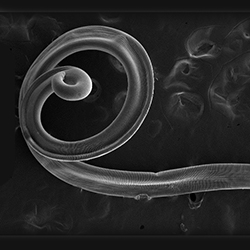By Ethan Covey
Thelaziosis, a disease caused by the Thelazia callipaeda eye worm, has been reported in two domestic cats in New York state, and is posing an increasing threat to cats and dogs (Emerg Infect Dis 2024;30[3]:591-594).

“The first case of this exotic eyeworm from a dog in New York was reported by Dr. Paul Schwartz in the Emerging Infectious Diseases in May 2021,” said Manigandan Lejeune, MVSc, PhD, an associate professor of practice in the Department of Population Medicine and Diagnostic Sciences at Cornell University College of Veterinary Medicine, in Ithaca, N.Y. “At the time of the first publication in EID, we were sure this parasite posed the threat of emergence in the USA, and now we are proven right.”
Until the initial canine case was identified in New York, T. callipaeda eye worm was considered an exotic parasite in North America.
As of February 2024, when the most recent report was published, 11 cases had been identified in dogs and two in cats. Following publication, one additional case has been confirmed in a dog from New Jersey.
“We have not done an active surveillance in Northeastern U.S., and the data reported in the article were based on passive surveillance through specimens submitted to the AHDC Parasitology lab at Cornell University, which is also the New York State Veterinary Diagnostic Lab,” Dr. Lejeune said. “I am sure that many such undocumented cases of this emerging parasite have occurred or are occurring in Northeastern U.S.”
The two cats referenced in the current report were both from New York: one from Orange County and the second from Duchess County. Both recovered after receiving treatment.
“Thelazia californiensis is native to North America, and we occasionally encounter this parasite in pet animals in the Northeast,” Dr. Lejeune said. “However, T. callipaeda is an exotic eye worm, and our study indicates its identify as the haplotype prevalent in Europe, meaning an introduction to North America from Europe. This parasite is transmitted by the fruit fly (Phortica variegata), which occurs in counties in the Northeast where we documented the recent emergence of T. callipaeda.”
Addressing the risk posed by T. callipaeda will require a One Health approach, the study authors wrote.
“This parasite can infect dogs, cats, wild animals and humans,” Dr. Lejeune said. “At this stage I am not aware of any incident in wild animals or humans in the U.S. However, there is high potential for its occurrence in humans and wildlife. We think that there must have been a wildlife reservoir already established in this region even before the first recorded dog case in 2021.”
Future studies should answer existing questions regarding the reservoir host and clarify the most effective treatment strategies to control infections in pets.
In addition, Dr. Lejeune noted that active surveillance in pets, shelter animals and wild carnivores would help to determine the true extent of the parasite and its vector spread in the United States.
{RELATED-HORIZONTAL}